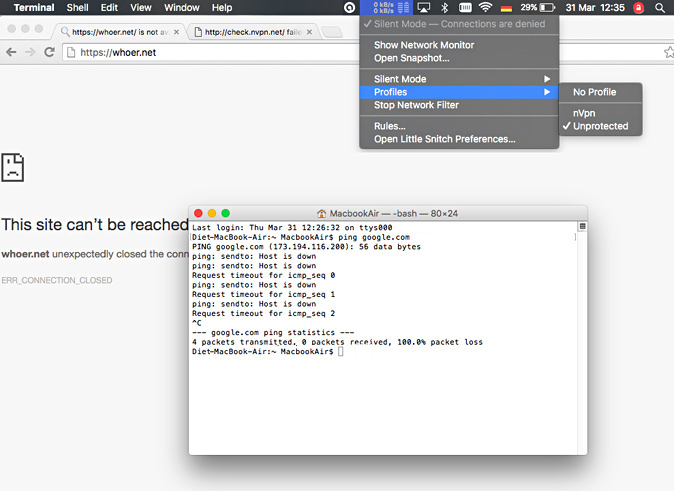Little Snitch is a popular Mac app that detects outbound connections and lets you set up rules to block those connections. Once installed, Little Snitch monitors your internet traffic and every time it detects an outbound connection, for example, Adobe Reader trying to access the internet, it pops up a window and ask you if you want to allow the connection one time, or make a rule to allow.
- Little Snitch Classes. If we load the Little Snitch kernel driver into a disassembler (IDA was used for the screenshots) we can notice a class named “atobdevLSNKE”. This is the main class of the driver as we can also observe in the driver Info.plist contents: Further class information can be extracted from the “const” section.
- Little Snitch Mac One of the biggest myth regarding computer security on an Apple Mac is your computer will never ever be infected with any malware. Due to the fact that most Apple Mac OS X user does not have any antivirus installed, let alone any fire wall, it becomes hackers favorite target.
Inspired from hosts lists projects, this is a unified place to subscribe rule groups based on all available sources of those hosts lists to block ads, malware, risk-ware, crypto-miner, phishing, tracking, telemetry, fake-news, adult and social domains. Oct 07, 2019 The latest installer for LittleSnitch, 4.4.3, is completely broken. It says you have to allow “Objective Development” as an approved developer in System Preferences. However, when you run the.
While we work on getting our iOS/iPadOS application approved through Apple, the links below are provided for those that wish to use Little Snitch to block ads, trackers, miners, etc. As for the look of the site, we wanted to get something up so those with Little Snitch could start using the rules. Little Snitch is a firewall application that monitors and controls outbound internet traffic. If you're looking for more info about Little Snitch like screenshots, reviews and comments you should visit our info page about it. Below you find the best alternatives.
Starting with macOS 10.15.4 the above “Legacy System Extension” message will be shown when Little Snitch is installed.

→ Please read this blog post to learn more about why this message is shown.

And its name is Melodyne.Manipulate audio as you had never done before.For quite some years Melodyne is the vocal correction software of reference used in recording studios all over the world. In the music world, singers and more specifically their music producers have different tricks to make a faulty recording become a perfect performance. The perfect tool to manipulate all sorts of audio files in an elastic and flexible manner, as if they were MIDI data.
Block Ipv4 On Little Snitch Online
On a Mac with macOS Catalina 10.15, open Finder. Will 3utools restore iphone.
Will there be an update of Little Snitch that’s compatible with macOS 10.16?
Yes. We are going to release Little Snitch 5 later this year, which will be compatible with macOS 10.16. → Learn more…
Block Ipv4 On Little Snitch Free
Will I get the update for free?
Yes. All licenses sold now include a free upgrade to Little Snitch 5. In addition, customers who purchased Little Snitch 4 within a one-year period prior to the final release of Little Snitch 5 will also get a free upgrade. → Learn more…


Will Little Snitch 4 run on macOS 10.16?

Little Snitch Discount
Little Snitch 4 will not be loaded on macOS 10.16 by default, but there will still be an option to allow the loading. → Learn more…
Little Snitch Reviews
- How to block Little Snitch from calling home and killing numbers:
- 1. The first step is to block Little Snitch with Little Snitch. Create two new rules in Little Snitch as below:
- a) Deny connections to Server Hostname http://www.obdev.at in LS Configuration. The address that will appear if you do it correctly is 80.237.144.65. Save.
- b) Deny connections in LS Config to the application Little Snitch UIAgent (navigate to /Library/Little Snitch/Little Snitch UIAgent.app, any server, any port.
- 2. After that is done, open the Terminal (in your Utilities) and paste in:
- sudo /Applications/TextEdit.app/Contents/MacOS/TextEdit /etc/hosts
- (Hit return and type in your admin password). A TextEdit window will open behind the Terminal window. Command+Tab to it - this is your hosts file.
- 3. Place your cursor at the end of the text there, type or leave one vertical space and paste in the following:
- 4. Close TextEdit, hit Command+Tab to return to the Terminal window, and paste in the following:
- 5. Hit the Return key and quit Terminal. You're finished now.
- 6. Easy, isn't it. If only everyone would do this, the developer would cease and desist from killing the number that you personally are using successfully on your Mac. At least until the next version is released…